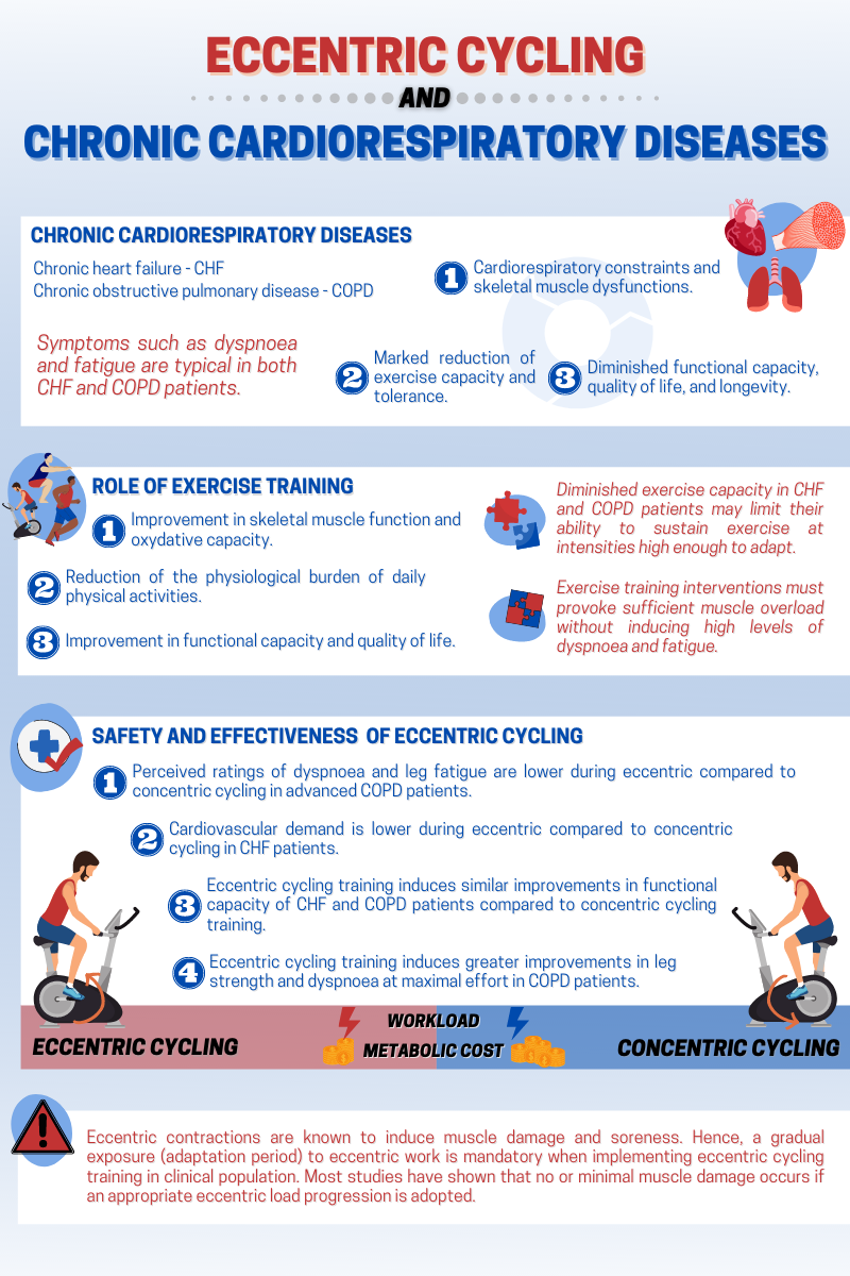Greater mechanical load associated with lesser cardiorespiratory strain during eccentric cycling can make exercise sessions less demanding while further improving functionality
Exercise intolerance is a defining symptom of chronic cardiorespiratory diseases such as chronic heart failure (CHF) and chronic obstructive pulmonary disease (COPD).1,2 Cardiovascular and respiratory constraints as well as severe skeletal muscle dysfunction are both linked to the typically reduced exercise capacity observed in CHF and COPD patients.1,2 Indeed, a key determinant of quality of life and longevity in such patients is their functional capacity (i.e., six-minute walk test distance, 6MWD), which is closely related to skeletal muscle integrity (i.e., oxidative and contractile capacity).1,2
Therefore, exercise training is widely recommended in the treatment of CHF and COPD and typically consists of concentric cycling-based aerobic sessions and resistance exercises.1,2 However, it is a challenging task to prescribe exercises for these patients. Even modest exercise loads can excessively demand patients’ cardiorespiratory and musculoskeletal capacities, often inducing a high level of dyspnoea and perceived fatigue. Conversely, extremely low exercise loads may not be enough of a stimulus to induce physiological and/or structural muscle adaptations that lead to health-related benefits. Hence, it is paramount that exercise-training prescription to CHF and COPD patients produce enough stimuli to adapt without culminating in an exacerbated cardiorespiratory and psychophysical burden.
Eccentric Cycling – Solving the puzzle
Eccentric cycling has been proposed as a promising exercise modality to treat and condition clinical populations since significant mechanical loads can be applied to the muscles with low metabolic cost. Results of a systematic review showed that eccentric-biased exercises are safe and well tolerable for patients with CHF and COPD.3 Moreover, recent evidence indicates superior effects of eccentric over concentric cycling training in improving lower limb muscle strength in advanced COPD patients (post-bronchodilator forced expiratory volume in 1 s ≤ 50% predicted).4 Compared to concentric mode, eccentric cycling training induces similar improvements in several clinically relevant functional parameters (i.e., 6MWD, peak power output, exercise endurance time and the number of daily step counts), but a greater reduction of dyspnoea at peak power output of an incremental cycling test.4 Importantly, perceived dyspnoea during eccentric cycling sessions was significantly lower compared to concentric cycling sessions.4 Similarly, CHF patients can benefit from equivalent improvements in exercise capacity (i.e., 6MWD and oxygen uptake during 6MWD test) following eccentric or concentric cycling training.5 However, a lower heart rate was observed in the CHF patients enrolled in eccentric cycling training.5

Finally, robust evidence supports the adoption of eccentric cycling training as a safe and effective method to improve strength and functional capacities of patients with chronic cardiorespiratory diseases. Most importantly, eccentric cycling can be less psychophysically burdening than concentric-biased exercises, which could improve adherence and safety of the patients during exercise interventions.
Authors and affiliations:
Renan Vieira Barreto1, Leonardo Coelho Rabello Lima1, and Benedito Sérgio Denadai1
Renan Vieira Barreto – Master’s student at the São Paulo State University (E-mail: reenanvb@gmail.com).
Leonardo Coelho Rabello Lima – Assistant Professor at the São Paulo Salesian University Center (E-mail: leonardocrlima@gmail.com).
Benedito Sérgio Denadai – Visiting Professor at the Federal University of Santa Catarina (E-mail: benedito.denadai@unesp.br).
1Department of Physical Education, São Paulo State University, Rio Claro, Brazil.
Competing interests
None declared.
References
1 Taylor RS, Walker S, Smart NA, et al. Impact of Exercise Rehabilitation on Exercise Capacity and Quality-of-Life in Heart Failure: Individual Participant Meta-Analysis. J Am Coll Cardiol 2019;73:1430-1443.
2 Emtner M, Wadell K. Effects of exercise training in patients with chronic obstructive pulmonary disease – a narrative review for FYSS (Swedish Physical Activity Exercise Prescription Book). Br J Sports Med 2016;50:368-371.
3 Ellis R, Shields N, Lim K, Dodd KJ. Eccentric exercise in adults with cardiorespiratory disease: a systematic review. Clin Rehabil 2015;29:1178-1197.
4 Bourbeau J, De Sousa Sena R, Taivassalo T, et al. Eccentric versus conventional cycle training to improve muscle strength in advanced COPD: A randomized clinical trial. Respir Physiol Neurobiol 2020;276:103414.
5 Besson D, Joussain C, Gremeaux V, et al. Eccentric training in chronic heart failure: feasibility and functional effects. Results of a comparative study. Ann Phys Rehabil Med 2013;56:30-40.